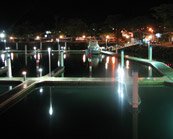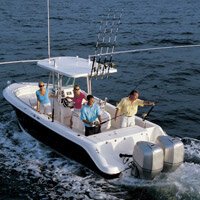 High-end fishing electronics used to be the domain of big, commercial fishing fleets. They can see their nets, schools of fish, birds 20 miles away and all manner of other telltale signs. The technology to accomplish all this cost several piles of money and so only bigger vessels could afford it. Until now.
High-end fishing electronics used to be the domain of big, commercial fishing fleets. They can see their nets, schools of fish, birds 20 miles away and all manner of other telltale signs. The technology to accomplish all this cost several piles of money and so only bigger vessels could afford it. Until now.
Not only has the cost of technology come down dramatically, marine electronics manufacturers previously considered strictly small boat or freshwater have debuted full lines of electronics from chart plotters to VHF radios to radar. And it all interfaces with everything else.
Today, even the lowliest center console angler can afford virtually the same technology, allowing him or her to find all the fish they could want or need, preferably with emphasis on “need.” Carrying that responsible steward concept over to the professional side, commercial fisherman must be more conscientious than ever since today’s technology affords them the ability to find and vacuum every fish out of the sea if that’s what they choose to do. Fortunately for us all, the majority of North American commercial fisherman feel enough responsibility toward the resource that it’s not likely to reach such dire straits here. Unfortunately, other countries don’t labor under the same ethical sense of responsibility.
So what kinds of technology allow even the little guy to become a big fish?
Most chart plotters now subscribe to one of the major cartography companies, all of which offer bathymetric charts in addition to standard raster and vector fare. In addition, the choice between raster and vector no longer represents the stumbling block it once did, now that they both look so similar. Anglers can move a cursor to a particular fishing spot or plug in lat/lon coordinates and with the press of a button, be on their way. Set and drift no longer matter since steering directors keep you on whatever crab angle you need to reach your destination.
Sonar
Once at the desired location, today’s sonar can reach depths of thousands of feet without losing lock. Never have filtering, pulse rate and beam configuration provided such clear images of what’s below. Where once a school of baitfish looked like a big blob, now even some low-cost units can discern individual baitfish.
Interfacing electronics has added incredible power to an angler’s arsenal. Imagine seeing your bottom structure objective hove into view on your sounder display. Quickly move the cross-hatch cursor to that spot and it marks not only the exact depth, it plugs the exact lat/lon position into your chart plotter at the same time.
Combine the bathymetric cartography with the sonar and you can see the fish holding around the actual structure. With scanning sonar, you can even see fish hiding under a ledge.
Scanning sonar, too, has come a long way. Sure, you can spend a fortune on searchlight sonar that drops out of your vessel’s bottom and lights up everything around you. But again, companies like Humminbird, formerly the bastion of bass fisherman nationwide, have extraordinary side-scanning sonar with displays that look like video.
Radar
Many types of offshore fishing use radar to spot flocks of birds feeding over a school of fish. Not long ago, tuna boats used 25kW units or bigger to accomplish this reconnaissance. Then 10-kW units handled the job. Today, several 4-kW radars have the ability to pick out flocks of birds at up to five miles. Here comes interfacing again. Move the cursor on the radar display to the “cloud” representing the flock of birds and press a button. That spot translates into a waypoint on the chart plotter, providing lat/lon position, distance, bearing and a quick glance at the MARPA-equipped radar display can tell the user in which direction the flock is heading.
Autopilots
Autopilots, too, have advanced to the point where by interfacing with the GPS and benefiting from a little computer wizardry, recreational fishing captains can automatically run pre-programmed trolling patterns, figure eights and spirals around a waypoint or even execute a Williamson turn in response to a man overboard —all at the press of a single button.
Systems Integration
Interfacing represents the greatest breakthrough in marine electronics in decades. With the inclusion of NMEA 2000®, Ethernet and CAN into the electronics mix, the 26-foot center console can enjoy most of the capabilities previously exclusive to such advanced vessels as oil-exploration drill ships and seismic research vessels.
For example, both Cummins MerCruiser and Volvo Penta now manufacture articulating-pod propulsion systems (similar to azipods in use on large ships) that work on fly-by-wire. Low-speed maneuvering — accomplished via the use of a joystick — eliminates the need for bow or stern thrusters. Computer programming affords the helmsman the ability to move the vessel in any direction. More impressive still, an attendant feature available with Cummins today and with Volvo in the very near future, dynamic positioning has come to small recreational vessels. With input from dual GPS antennas, the pod drives (Zeus system at Cummins MerCruiser and IPS at Volvo Penta) automatically adjust to maintain position within inches against wind, current or even human intervention. Parked next to a dock, we recently pushed a boat away physically, only to watch the boat sidle immediately back to its original position.
How does this pose a fishing advantage, you ask? To name just two possibilities:
Bottom fishermen often must spend a half-hour or more trying to anchor in exactly the right spot over a piece of bottom structure, adjusting for current and wind. No longer. Now, when an angler reaches the sweet spot, he just presses a button and holds position.
Or sailfishing in Florida using kites will be easier. Without dynamic positioning, someone must stand at the helm bumping the engines in and out of gear to maintain the proper angle to the wind and geographical position. Now, pressing one button ends the
procedure.
The interfacing doesn’t stop there, either. In addition to fly-by-wire control for steering as well as throttle and shift, the industry (especially Mercury) is moving at a swift pace toward every piece of electronic equipment aboard interfacing with everything else. In Mercury’s SmartCraft, the engine, navigation electronics, multiple-station controls, video and other sensor points all combine for display on one or more screens at the helm.
And if capability alone doesn’t set you aflutter, all this can be considered boating on a budget.
Underwater Lights
A rapidly growing trend among recreational boat owners is the installation of high-powered underwater lights. Available in both AC (usually with metal halide lamps) and DC (using xenon lamps), these lights most frequently mount in the transom and freeboard just above the chine, shining light out and away from the boat. Not only does it showcase the boat at night, it attracts many baitfish, which in turn can attract larger predatory fish.
Voice Scramblers
Another big-ticket, military-type item that has trickled down to recreational boating is scrambled VHF communications. Certainly you can get away with privacy on most DSC radios simply by targeting a specific MMSI number when communicating. But lately, several companies have enjoyed sales spurts in actual scrambling technology in regular VHF communications.
Why? Here’s just one example: I went tarpon fishing near Boca Grande Pass on Florida’s west coast. The pass was full of boats ramming each other trying to catch fish, so we headed out to the shallow waters along the beach to look for shadows. That’s what you see a school of tarpon create against the white sandy bottom. The guide found a large school with nobody else around. He picked up his VHF microphone and called two of his guiding friends to tell them where he’d found a big school and that they should join him. I had my handheld VHF in the mesh pocket of my bag. When my guide broadcast, all I heard was static and gibberish. Only the select few guides he meant to be included were able to receive and translate the “insider info” that allowed them to put their clients on fish when nobody else could.
Two kinds of technology are available to recreational boats: Voice-inversion scrambling (entry-level technology) protects your conversation from casual listeners by making it sound like gibberish to someone without a matching receiver. The other—rolling-code scramblers—sounds like an electronic overload or a screeching modem, followed by gibberish.
Speech inversion works by inverting a signal (your transmission) around a preset frequency. On the reception end, the signal is descrambled. Rolling-code scrambling rapidly switches to randomly chosen frequencies, stays on one frequency for a random amount of time, then switches again. Rolling code typically engages in this switching process between six and 25 times per second.
Systems Monitors
Numerous companies offer the nautical equivalent of OnStar for cars. SeaKey, as one example, uses satellite communications integrated with your onboard monitoring systems. It can forward an engine problem to a shoreside mechanic for diagnosis or it can connect you to a concierge who will make dockage or dinner reservations.
All this amounts to saving time getting to the fishing spot, greater accuracy in finding the fish, easier maneuvering to catch fish and greater efficiencies when traveling which translate into money and time saved. That makes today’s marine electronics a far more valuable fishing tool than at any time in history. All we need to do now is remember to temper our desire for fish and our ease in finding and procuring it with a sense of responsibility keeping each of us from being the one to shoot the last buffalo.
About the author:
Dean Travis Clarke is executive editor at World Publications and host of Sport Fishing Magazine TV. He was a professional captain and served as chief electronics technician aboard the 12-meter Courageous in the 1983 America’s Cup.

